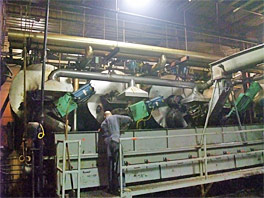
Insurance companies, fire marshals and other regulators have recently begun mandating that heat transfer fluids be used below their flashpoints.
While this certainly can add a measure of safety to a heat transfer system, it has often left manufacturers in a bind, forcing them to lower their operating temperatures, find a higher flashpoint fluid or cease operation altogether.
Atwood Pet Foods, one of Canada’s largest deadstock rendering operations, felt the effects of this firsthand in 2006. Ontario’s Technical Standards and Safety Authority (TSSA) mandated that their imported rendering batch cookers use fluid a full 50°F below its flash point. This meant the fluid needed a flashpoint above 500°F (260°C).
Facing costly equipment retrofitting or replacement, Atwood’s Ken Maltby soon found out it wasn’t going to be easy to find a suitable high-flashpoint thermal fluid.
“I contacted just about all of the thermal fluid vendors I could find, but it wasn’t until I called Duratherm that I found a suitable fluid with a high enough flashpoint,” Maltby said.
Duratherm not only had the correct fluid – they actually offered Atwood a choice of fluids with flashpoints that fit their needs. Following an extensive technical evaluation, it was determined that Duratherm G, one of the company’s high-oxidation resilient fluids, would be best suited.
Michael Bates, Duratherm’s Technical Director said: “Having 3 fluids with flashpoints above 500°F — and one as high as 615°F — means we’re able to offer customers not just a high-flashpoint fluid, but also one that satisfies other important criteria like system compatibility, suitability and oxidation or thermal stability.”
Since 2006 Atwood has added three more cookers at its facility in Atwood, Ontario. The company is currently in the midst of its most challenging project, which will see it construct a gasification system to destroy the contaminated beef protein. It will capture the energy from the process to heat the Duratherm thermal fluid, which will operate its rendering process.
This will enable Atwood to shut down its gas-fired thermal heater and eliminate the use of approximately 1,000,000 m3 of natural gas each year.
Learning Centre

Duratherm Recommended Sampling Procedures and Intervals
Duratherm fluids are engineered to have a long service life ... Read more

What’s the Difference Between a Flush and a System Cleaner?
We’re often asked for a flushing fluid when what’s really ... Read more

Preparation and Startup of New Systems
This document is offered as a general guideline to starting ... Read more
Sludge Series Part I: What Causes Sludge in Your System?
Sludge can be costly, but it's also preventable. In Part
Do You Need to Clean Your System?
If a system is improperly started or shut down or
Used Fluid and Drum Disposal
No matter which type of thermal fluid you use, you’ll